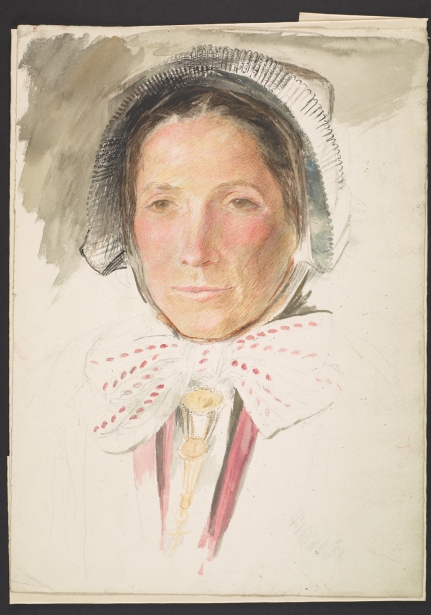
Christiana Herringham, Portrait of a woman wearing a black bonnet with a pink and white bow, c.1900
On 14 January 2019, Royal Holloway opened a new exhibition on Christiana Herringham (1852-1929), the first exhibition dedicated to her in almost seventy years. It is co-curated by Michaela Jones, a PhD student at Royal Holloway whose thesis focuses on the Herringham Collection, and by Dr Laura MacCulloch, the college curator. It is the culmination of almost four years of research and aims to explore Herringham’s extraordinary and multifaceted achievements.
Christiana Herringham (from 1914, Lady Herringham) was a dedicated supporter of women’s rights, working alongside her friend Millicent Fawcett in the fight for women’s suffrage by organising petitions, donating money, and creating banners for the cause. Her independent wealth meant that she was also able to support other women artists, by commissioning and purchasing the work of painters such as Annie Swynnerton.
She was also able to establish herself as a successful artist and a noted authority on art. In 1899 she published a translation of Cennino Cennini’s Il Libro dell’Arte. Originally written around 1400, the work is a treatise describing how to prepare panels, grind colours, and apply gilding to paintings and frames. Herringham’s translation established her as a leading figure in the emergent British Tempera Revival; a position which was cemented in 1901 when she co-founded the Society of Painters in Tempera.
Herringham travelled extensively to Europe and beyond in pursuit of her art. She travelled to India on three occasions between 1906 and 1911, purchasing Indian art and undertaking an ambitious project to create a series of copies of the ancient frescoes in the Ajanta Caves.
In Britain, her legacy lives on through the work of the Art Fund. In 1903, she donated £200 to cover the initial start-up costs of the organisation; an achievement acknowledged by the Art Fund by their financial support of the exhibition.
Despite her numerous achievements, she was largely forgotten in the decades following her death. Her erasure from the art historical record seems to have been at least partly due to her admission to a mental asylum in 1911, following her final trip to India, and where she remained until her death in 1929.

A rare photograph of Christiana Herringham taken in India, c.1906-11, RHUL Archives
The Herringham Collection forms approximately one-third of the fine art collection at Royal Holloway, and comprises both Herringham’s own work, and artworks which formed part of her own private collection. This collection, in addition to many of Herringham’s books and photograph albums, was originally gifted to Bedford College by her husband, Wilmot Herringham, who shared his wife’s interest in women’s education and served as the chair of the committee of Bedford College.
After the merger of Bedford College and Royal Holloway in 1985 many of the items, including Herringham’s photograph albums and a portfolio of 120 of her sketches and watercolours, were misplaced and forgotten. These items were not rediscovered until 2014.
The exhibition at Royal Holloway brings together many of these recently rediscovered works for the first time. Combined with research undertaken by Michaela for her PhD, it highlights both a significant aspect of the college’s art collections and the achievements of a woman who has largely been forgotten and is just now beginning to be restored to the historical narrative.
The exhibition is taking place in the Exhibition Space of the Emily Wilding Davison Building, and is open daily from the 14 of January to the 8 of March 2019. Admission is free, and a series of talks and events are being held throughout the exhibition’s run.
Michaela Jones is a PhD student at Royal Holloway, in the final stages of completing her thesis entitled ‘Christiana Herringham and the Art Collections of Royal Holloway and Bedford New College.’


